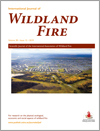International Journal of Wildland Fire
Volume 28
Number 12 2019
Wildland fire scientists and land managers working in fire-prone areas require spatial estimates of wildland fire potential. A method called burn probability modelling was developed to fulfil this need. This review describes this approach and provides an overview of its applications in wildland fire research, risk analysis and land management.
A large variability of fire cycles, mean fire size and fire occurrence was observed in eastern Canada. Although the ignition source of natural fires, lightning strikes did not limit fire occurrence. Instead, it was controlled by climate and relief, whereas the mean fire size was controlled by climate and surficial deposits.
Spot fires caused by embers lofted during wildland fires are a significant avenue for fire spread. This work sought to determine the relative importance of several parameters that affect the time required for embers to be formed. It was observed that the size and the species of the sample have the largest impact on the time required to generate an ember.
We found that two widely used remote-sensing-derived indices of burn severity, the difference Normalised Burn Ratio (dNBR) and relativised difference Normalised Burn Ratio (RdNBR), performed well in the Mojave Desert and will likely be powerful tools for fire scientists and managers in many other arid systems.
Bark thickness is a better predictor of bark resistance to heating than bark moisture, surface structure and density. FireStem2D, a numerical model incorporating bark thermal properties and heat transfer mechanisms, performs better than traditional analytical model in prediction of cambial injury.
Although a backfiring operation was applied under mid-summer conditions, rate of survival of ponderosa pine trees (diameter of breast height averaging 12.0 cm (1.0–33.8) and height averaging 7.1 m (1.8–17.4)) in a plantation was high. Tree density and shrub abundance did not significantly influence tree survival, likely owing to the combination of burning conditions interacting with stand structure and fuels. A lack of negative effects of the backfiring operation was possibly a result of the release from inter-tree and shrub competition, which offset bole injury or crown loss.
Forest duff is composed of decomposing organic materials that are typically unavailable for wildfires to consume because of its high moisture content in the south-eastern United States. However, duff can be burned substantially under persistent drought conditions. This study examines a case of wildfire amid long-term drought and identifies the critical role of duff burning in the production of air pollution in a downwind metropolitan region. The BlueSky framework under-predicted the fuel loading, fuel consumption, and fire emissions obtained based on the field measurements.
 , Denyse A. Dawe, Carol Miller, Christopher A. Stockdale and O. Bradley Armitage
, Denyse A. Dawe, Carol Miller, Christopher A. Stockdale and O. Bradley Armitage




